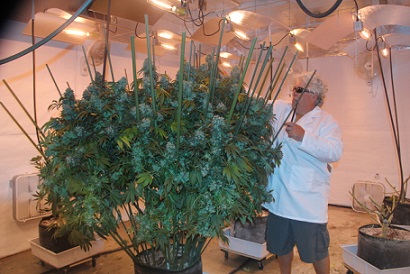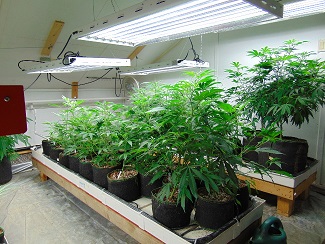Log In To Your Account
Log In With Facebook
Growing indoors and simulating natural sunlight can get tricky! CannaFo is ready to help, with resources covering the many different ways to grow inside from cloning to sexing, we’ve got you covered! There are many opinions on how to get the most out of a grow, and CannaFo is here to provide you with as much information as possible to help you determine the best choice that fits your needs.
 Prior to the legalization of medical marijuana, growers had to take the underground approach to cannabis gardening. They had to resort to such tactics as finding remote locations, converting old barns, utilizing large basements, and burying trailers all while using streetlights. And well before the medical benefits of cannabis were recognized, it was known for its stress-relieving therapeutic factors known as the high.” There is no doubt that this helped make it such a popular plant throughout what is commonly referred to as The Second Prohibition.”
Prior to the legalization of medical marijuana, growers had to take the underground approach to cannabis gardening. They had to resort to such tactics as finding remote locations, converting old barns, utilizing large basements, and burying trailers all while using streetlights. And well before the medical benefits of cannabis were recognized, it was known for its stress-relieving therapeutic factors known as the high.” There is no doubt that this helped make it such a popular plant throughout what is commonly referred to as The Second Prohibition.”
As time passed and technology improved, so did the ability to grow indoors. However, it is important to remember that there are still a number of states where cannabis cultivation is illegal, and therefore growing is still being conducted indoors. CannaFo does not condone illegal underground grows, but does recognize that they still exist, and it is because of the illegal nature of grows that indoor growing became so efficient.
Before deciding on how to grow using this popular method, much consideration must be taken into the size of the budget and amount of time that will be dedicated to it. Some types are more expensive and require more of a daily commitment than others, so it is wise to consider these factors when trying to decide on what kind of grow operation will be built. In addition, growing indoors requires different equipment than outdoor growing. Because of advanced technology, an indoor grow can be created on a low budget using prefabricated, fully self-contained grow tents or with a nice investment of time and money, one could establish a really consistent and profitable grow operation.
All indoor grows will require lighting which affects the production of the grow. Lighting can be expensive, so one should do their research when budgeting for this cost. In addition to lighting, there is ventilation, temperature and humidity controls. These additional factors will drive up power costs and ultimately affect the budget and size of the grow. Estimating power usage for the size of grow intended will help determine which grow method you wish to conduct.
An additional consideration that affects the bottom line is the choice of grow medium. Not all indoor grow methods will require a medium other than water, but for those that do, there will be that added expense. Gaining in popularity among indoor growers is the use of coco coir as a base and mixing in some other amendments.
As mentioned earlier, the time dedicated to the grow deserves some serious consideration as well. We have all heard the phrase that time is money” and it is very true when it comes to growing cannabis! The more time invested in the grow will increase the likelihood of a very rewarding harvest, so you need to ask yourself how much time do you want to invest? Do I want to hand water or auto feed? What types of nutrients and grow mediums should I use and a host of other factors to consider.
Listed below are things to consider before beginning an indoor grow:
Advantages
Controlled environment
Year-round grows
Higher overall quality
Potentially higher annual yields
Ability to utilize the latest technology
Disadvantages
Comprehensive higher construction costs
Higher power costs
More advanced maintenance
Greater labor costs
Overall higher per square footage costs when buying or renting
Difficulty finding the perfect location
Maintaining odor control in some areas
Probably the most beneficial factor about performing an indoor grow is having complete control of the environment that it provides. Light cycles, grow mediums, airflow, temperature, humidity and nutrient cycles are all at the discretion of the grower. Thus, this type of control leads to year-round yields of high quality cannabis. Indoor cultivation also allows the grower to work simultaneously with a multitude of plants at different stages of growth. This can be achieved by having two or more growing areas, typically one on a 12/12 photoperiod for flowering and the other on 18/6 or more for vegetative growth. This set-up allows for a rolling,” or perpetual harvest where a number of plants are put into and harvested from the flowering area every week or two. Until recently, this technique was unique to indoor growing. Some large grows have a number of grows cycling through this type of rotation. There will be more discussion on this topic when we visit the topic of Greenhouse Grows.
 Another benefit to consider is the protection from the elements which eliminates seasonal restrictions. The only real restriction is the actual time involved in the growing process itself. In addition, growing indoors diminishes the likelihood of a pest infestation, if properly controlled. However, that also means a reduced exposure to beneficial insects (insects that prey on other insects) that will remove the pests. This has the potential for a more extreme infestation than might be experienced outdoors.
Another benefit to consider is the protection from the elements which eliminates seasonal restrictions. The only real restriction is the actual time involved in the growing process itself. In addition, growing indoors diminishes the likelihood of a pest infestation, if properly controlled. However, that also means a reduced exposure to beneficial insects (insects that prey on other insects) that will remove the pests. This has the potential for a more extreme infestation than might be experienced outdoors.
Indoor plants can see a substantial improvement in the quality of resin that coats the flowers as a result of this controlled space. They are not affected by environmental factors such as wind and rain which can damage the glands. This can also result in a higher THC composition.
When all of these factors are effectively managed the usual result is a far more potent crop achieved in a shorter space of time than could ever be possible with an outdoor grow. There are a number of techniques that will be discussed later that will also help to improve crop yields.
Indoor cultivation also allows the grower to decide exactly when to induce flowering, giving more control over the speed and size of the crop, resulting in higher crop yields. This means managing the light cycle to prolong the vegetative state so the grower may use various cultivation techniques that will increase yield and quality.
Grow-lights provide plants a consistently direct, intense light for their entire daytime” cycle. This is not possible when growing with sunlight. More direct light generally results in denser, more resinous buds and a more compact plant. Of course, the use of lighting for an indoor grow does mean there is going to be a lot of power consumed, hence the need to maximize yield.
Another great benefit in having a two-cycle growing area allows the possibility of keeping mother-plants” and making clones. Cloning enables a grower to preserve the individual genetics of one favorite plant for as long as they desire. Keeping a female plant in a perpetual 18/6 photoperiod allows it to continue vegetating for an indefinite period of time. Any shoots cut from this mother plant can then be rooted and grown in a vegetative stage until ready to be switched to a flowering stage. This means the grower is able to flower many exact copies of the mother while retaining the master copy” in the vegetative area.
Cultivating clones can also provide an additional revenue stream. For example, Charlotte’s Web is a popular medical strain that is seeing an increase in demand. Selling clones of this strain could provide a steady stream of revenue for years to come, especially as more states approve medical marijuana.

Cannafo news administration team.